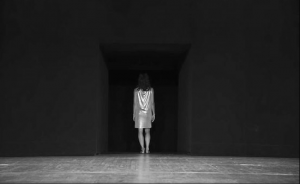As you enter the theatre, instead of the stalls there is a tier covered with mattresses and cushions. You’re invited to make yourself comfortable. On stage, dancer and co-author of the piece Alix Eynaudi tells you what is going to happen. First there will be a video talking about sleep; later Alix will come on stage, carry out a series of very slow movements and then exit. She will do this over and over again. She also tells us that the aim of the piece is to send us to sleep.
And it works. Even though I try to stay awake, the slow repetition makes my eyelids grow heavier and heavier. You start to hear the sound of snoring from the audience. I peep at the show through half-open eyes. I’m comforted by the feeling that I am one of fifty people falling asleep at the same time in the same room. In the darkness, though, I can make out people refusing to be lulled to sleep.
The show is over. We wake up. Some more easily than others. A few have almost got sleep in their eyes. It’s nice to see people stretching, observe the cushions strewn all over the place and hear a strange silence in the room. In the foyer, the Belgian ambassador in Tallinn is giving out Belgian beer. Have a nice breakfast.
You could say that what Kris Verdonck does is industrial theatre if we accept that since the second half of the 20th century industry has no longer been concerned with transforming materials but changing behaviour. It’s no longer about selling things, but selling habits. As a result, the focus for transforming materials has changed and some artists are starting to see behaviour rather than objects as their work material.
The second avant-gardes gave up manufacturing objects and started to question themselves and create things through action. Some did so to free art from its commercial shackles; others, to get it out of its temples and back on the street, where it could take a political stance; others still, to re-consecrate artistic work. But from a present-day perspective, in all these cases it was about judging behaviour as artistic material, which by any reckoning has always been the theatre’s responsibility.
However, this new look at behaviour was no longer in debt to the craftsmanship of the theatre. The eager-eyed artists who come to the universe of the theatre were far removed from the old techniques that theatre had amassed for centuries. Representation, stage design, actors, costumes, rehearsals were words that took on new meaning from the perspective of the visual arts — hardly surprising, given that the universe of the theatre had been plundered purely for the purposes of show since the start of the 20th century. Now artists were trying to respond to the increasingly razzle-dazzle world with their own vocabulary.
In the early 21st century, the theatre is seeing a new generation of theatre artists who have assimilated a specialist vocabulary that was once its own but which has now been redefined by politics and art. Kris Verdonck is a good example.
